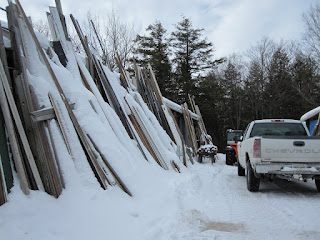On Saturday, 5 February 2011, it was time for Jacobson Construction to hit the road. We had come to a very important junction in the construction of the bookshelves: we needed a mantle.
In my mind the piece must be wooden, the problem being that to find a piece of wood that has such huge dimensions (10' long x 17" wide x 2"-3" deep) is well nigh impossible. So it was off to Acton Ontario where resides our good friend Allan Bousfield at Historic Lumber...
I met Allan on a jobsite in Camlachie where he was installing one of his vintage floors. The planks are stripped from a circa 1800 house, scraped down, reinstalled, and finally finished with three coats of polyurethane. The results are truly astounding. To see more of what Allan and his friends do at Historic Lumber, visit him at http://historiclumber.ca/
When I arrived in Acton, I was immediately struck by just how much lumber there is. Great, huge piles of it. The bulk of it is white pine, as that tree was plentiful in the area at the time. There are anything from rough floorboards from farm buildings, to huge 3" thick planks that were the actual walls of buildings, secured with a pin at the midway point to keep them from racking.
Allan patiently took me around to the different piles, calmly informing me of how rare the dimensions are that I was looking for. Finally, after much humming and hawing, I landed on one particular board...
This beauty. Taken from the floor of a farm building, where generations of horses and wagons had beaten a deep, rich colour into the wood, this piece jumped out at me from the moment I saw it. 11' long. 20" wide! 2 1/4" deep. The dimensions were perfect.
Note the pattern of the floor joists on the bottom of the board.
With the easy part of selection over, it was now time to sand... and sand... and sand.
First with my angle grinder. The large, 40 grit sanding wheel allows me to get into all of the nooks and crannies of a piece that is not flat at all. Nor do we wish to make it flat. One must be careful not to remove any more wood than is absolutely necessary. We wouldn't want to lose any of that great colour.
After the angle grinder, the rest of the work was done with sandpaper in hand. There is no better way to get into all hills and valleys. 60 grit, 100 grit, and finished with 150 grit.
Yes, you could use a random-orbit sander, but I have never liked those things. I find they just tear the fibers. I find I get a better finish just sanding with the grain by hand.
Here is the piece ready to receive its first coat of varnish. It has been sanded, vacuumed and brought inside.
The square holes are from the pins used to hold the board down when it first lay on the barn floor.
It's alive! Look at that colour. No, there is no stain on that piece. It is just the colour of over 100 years of history. Two more coats to come.
Salvaging lumber is a great practice. It is green as green can be. We use a product that otherwise ends up in a landfill or fire pit. We save a new tree from getting chopped down. And we get a one-of-kind piece that will be a highlight in any home.
Happy Sanding!









Great Post! What are you using to coat this fine looking piece wood?
ReplyDeleteThanks for your interest.
ReplyDeleteThe mantle is finished with 3 coats of satin polyurethane, an oil-based product.